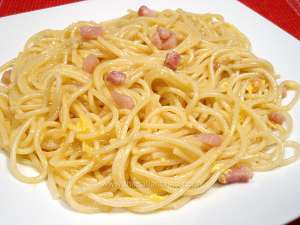Carbonara pasta
(
Spaghetti alla carbonara
)
Ingredients / Serves 4
- 280 g (10 oz) Italian spaghetti
- 100 g (3 1/2oz) bacon, cubed
- 2 eggs
- 2 tablespoons extra virgin olive oil
- 40 g (1 1/2oz) grated Pecorino cheese
- 40 g (1 1/2oz) grated Parmesan cheese
- Salt
- Freshly ground pepper, if you like
- Difficulty:
- easy recipe
- Time: preparation: 5 minutes
- How many calories in a serving?
- Calories:
490 (kcal)
25 % -
2052 (kJ)
Protein: 22.3 (g) 45 % GDA
Total fat: 21.5 (g) 31 % GDA
Total carbohydrate: 55.4 (g) 21 % GDA
Sugars: 3.0 (g) 4 % GDA
cooking: 20 minutes
Download free PDF version (284 download).
Cook spaghetti in a large kettle of boiling salted water according to package directions, until al dente.
Pasta must be al dente because you have to finish cooking it in the sauce.
In the meantime, simmer bacon in a wide frying pan with the olive oil, stirring, until it browns on all sides.
Beat the eggs with a pinch of salt and grated cheeses. Season to taste with pepper, if you like.
Drain spaghetti very well, pour into the frying pan and stir in order to flavor pasta.
Then add the beaten eggs. Stir accurately, keeping the pan lightly lifted over the flame to avoid eggs cook: they must warm up, not cook!
The secret of this creamy first course lies in this step.
Serve immediately.
Note
- - For a low fat recipe we simmered bacon in a frying pan with a few drops of water without olive oil and we used vegetable light cream.
- - We used red chilli instead of freshly ground pepper, adding it to the simmering bacon.
What's the right wine for " Carbonara pasta "?
Our suggestion is: Frascati Secco (a white wine from Italy).
A little history
The origin of this recipe is uncertain. Somebody says it was taken from Umbria to Rome by revolutionaries in the nineteenth century; other people say it belongs to a Neapolitan noble, Ippolito Cavalcanti, who published this recipe in a book of yours.
But the great surprise for you is another version: this dish could derive from the union of ingredients and ideas between the U.S.A. soldiers, arrived in Rome in 1944, and the chefs of the local restaurants.
The soldiers had got bacon and powdered eggs, the chefs their fantasy and so this creamy first course was born.
